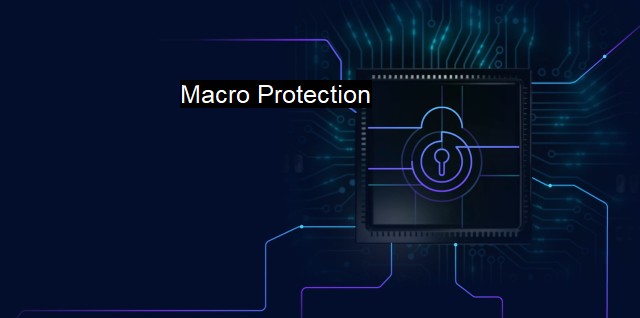What is Macro Protection?
Essentiality of Macro Protection in Cybersecurity: Safeguarding Against Malicious Exploits in Microsoft Office Documents
Macro protection is a crucial component of cybersecurity and antivirus software solutions. It offers a line of defense against malicious macro viruses, effectively adding an additional layer of safety to our increasingly digital domain. As we delve into discussing macro protection as a cybersecurity measure, it's necessary first to understand what 'macros' are.Macros are miniature programs that automate complex or repetitive tasks. Typically residing in spreadsheet programs or word processors such as Microsoft Word or Excel, they execute their programmed set of directions when triggered. Macros can be incredibly useful due to their ability to streamline workflows and make sophisticated tasks achievable with a single click. their phenomenal power is also a source of potential security risks. Because macros can be pooled within files and shared across networks, they have become a preferred vehicle for cybercriminals to deliver malicious code.
This is where the relevance of macro protection, within the context of cybersecurity and antivirus software, kicks in. Macro protection facilitates the safeguarding of system resources against threats like macro viruses. Macro viruses are malicious programs concealed within innocuous-looking macros. They slyly infiltrate your computer system when macros in an infected document are enabled. Once they have invaded a system, macro viruses can manipulate applications, delete files, corrupt data, and even send uninvited emails.
Given the complexity of the threats posed by macro viruses, macro protection involves several lines of defense; among them anti-virus shields, macro-permission restrictions, and the isolation of potentially suspicious files.
Antivirus shields are perpetually alert against macro threats, ensuring your local, network, and cloud-based resources are protected in real-time. Updates are continually provided to keep the antivirus profiles abreast of the ever-evolving macro viruses.
Macro permission restrictions engage the user directly in protecting their resources. a barrier is created to keep unknown macros from running without the user's explicit blessing. Software suites such as Microsoft Office have implemented such features, where macros embedded in documents are disabled by default and can only run if the user deliberately permits them to.
Lastly, macro protection also involves spotting and isolating suspicious files before they can inflict harm. Advanced heuristic methodologies and artificial intelligence algorithms are utilized to predictively identify potential macro viruses based on patterns and behaviors. Once identified, the potentially harmful files are either kept in quarantine or their digital signature is logged to fortify the system's layered protections.
Macro protection involves ceaseless surveillance coupled with proactive measures to design an environment where macro viruses can't maneuver. An approach that not only neutralizes known threats of malicious macros but also aims to nip future ones in the bud.
Macro protection is not just a necessity for large corporations or government agencies; it is vital for home computers too. In this era, where we optimistically start from the presumption that all devices are potentially insecure, macro protection demonstrates its worth by shortchanging macro-based vulnerabilities rampant in spreadsheets or documents - the tools that comprise our day-to-day toolkit.
With the myriad of activities we perform on digital devices and the wealth of confidential information they store, ignoring macro protection would be akin to leaving one's doors unlocked in a crime-prone neighborhood. Comprehensive macro protection does not guarantee absolute protection from all cyber threats, but it considerably mitigates risks by shielding us from the insidious world of macro viruses.

Macro Protection FAQs
What is macro protection?
Macro protection is a cybersecurity measure that aims to prevent malicious macros from executing on a computer system. It involves using antivirus software or other security tools to scan and block macros that could potentially harm the system.Why is macro protection important?
Macro protection is important because macros have been used by cybercriminals to deliver malware and other types of cyber threats. By blocking malicious macros, macro protection helps to keep computer systems safe from these threats.How does macro protection work?
Macro protection works by scanning macros for potentially harmful code or behavior. If a macro is flagged as suspicious, the protection software will block it from executing on the system. Some macro protection solutions may also provide other security features, such as email filtering and web browsing protection.Can macro protection be bypassed by attackers?
While no security measure is completely foolproof, macro protection can be effective at preventing a wide range of cyber threats. However, attackers may try to bypass macro protection by using advanced techniques, such as obfuscation or polymorphism, to evade detection. It's important to keep macro protection software up-to-date and to use other security measures, such as anti-phishing training and network segmentation, to reduce the risk of successful attacks.| | A | | | B | | | C | | | D | | | E | | | F | | | G | | | H | | | I | | | J | | | K | | | L | | | M | |
| | N | | | O | | | P | | | Q | | | R | | | S | | | T | | | U | | | V | | | W | | | X | | | Y | | | Z | |
| | 1 | | | 2 | | | 3 | | | 4 | | | 7 | | | 8 | | |||||||